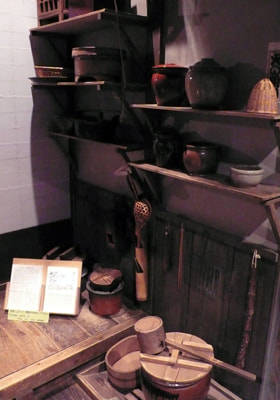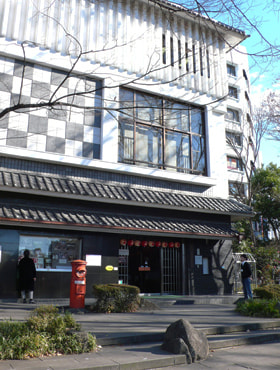
Shitamachi Museum
Row houses and stores surrounded by narrow alleys before the Kanto Great Earthquake hit, which still keep a taste of good old Edo, are reproduced in Taito City Shitamachi Museum or Old Town Folk Craft Museum.
Materials, household appliances, toys and goods used for annual events, which are related to areas centering on Taito City, are also exhibited. Visitors can feel a seasonal charm and life of Tokyo's Shitamachi area. (2-1 Ueno Park, Taito City: near JR Ueno Station Shinobazu exit or Keisei Ueno Station)
Materials, household appliances, toys and goods used for annual events, which are related to areas centering on Taito City, are also exhibited. Visitors can feel a seasonal charm and life of Tokyo's Shitamachi area. (2-1 Ueno Park, Taito City: near JR Ueno Station Shinobazu exit or Keisei Ueno Station)
Shitamachi Museum'sWebsite

Pleasant memories of childhood are quickly brought back in front of an old-fashioned penny candy store. "Chinpi" (Citrus unshiu peel - dried peels used as a medicine), lantern plants, garlic, "Funori" (used as laundry starch or shampoo) and others are hung under the eaves.
In Taito City, traces of the Edo Period could be found until the Meiji and Taisho Periods, but most of those vestiges were lost due to the Kanto Great Earthquake in 1923 and the war damage suffered in 1945. Also, the Tokyo Olympic Games in 1964 triggered the redevelopment of the town, and its appearance was greatly changed. Since cultures dating back to the Edo Period and traces of the Meiji, Taisho and Showa Periods have been continuously lost, Taito City Shitamachi Museum was established on October 1, 1980, in a quiet neighborhood near Shinobazu-no Ike Pond in order to pass down common people's history, lives and memories to the next generation.
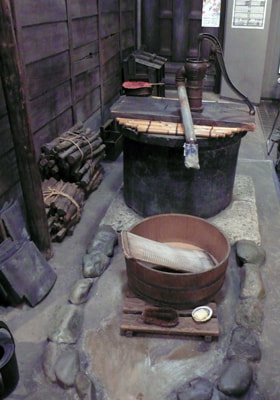
A part of the Shitamachi area in the Taisho Period, which was not yet destroyed by the Kanto Great Earthquake, is reproduced on the first floor of the museum. A nostalgic well is reproduced, around which a washtub, washboard, scouring brush and others are placed. Hand-operated pumps, made by casting, became widely used since the late Meiji Period. The cotton bag attached to the end of the pipe, which is seen in the picture, works as a filter straining out dust and iron rust.

Firewood and garbage box are placed beside the kitchen furnace. Garbage of each household in entire Tokyo City began to be publicly collected since 1918. Garbage boxes began to be placed in alleys. Wells and garbage boxes were used communally by row house tenants in the same way as alleys were.
A charcoal cooking stove, water jar, cooked-rice container are placed in a kitchen of the row house. The small space is effectively used. It seems as if a housewife appears from the backroom.

At the end of an alley, there is a work site of an artisan who made and repaired copper kettles, which were used on braziers. Pairs of pliers, a vise and fireplace are seen in this work site which is located in his house.
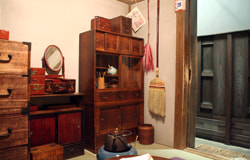
These low dining table, small dressing table, sewing box, "Kukedai" stand and others in the candy store, run by an aged mother and her daughter, reflect their modest, simple lives. Humaneness and temperament particular to the Shitamachi area was nurtured through such a life in these row houses, which shared a well and alleys.
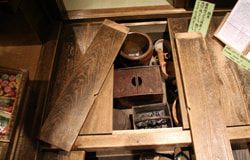
There is an "Ageita" floorboard in the kitchen. Tools and foods were stored under the floorboard.
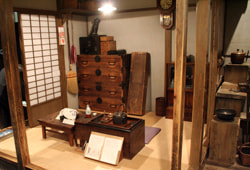
In this house of a copper smith, a paulownia wood chest, oblong brazier and box of samisen, which he practiced, can be seen.

Shitamachi Museum
Row houses and stores surrounded by narrow alleys before the Kanto Great Earthquake hit, which still keep a taste of good old Edo, are reproduced in Taito City Shitamachi Museum or Old Town Folk Craft Museum.
Materials, household appliances, toys and goods used for annual events, which are related to areas centering on Taito City, are also exhibited. Visitors can feel a seasonal charm and life of Tokyo's Shitamachi area. (2-1 Ueno Park, Taito City: near JR Ueno Station Shinobazu exit or Keisei Ueno Station)
Materials, household appliances, toys and goods used for annual events, which are related to areas centering on Taito City, are also exhibited. Visitors can feel a seasonal charm and life of Tokyo's Shitamachi area. (2-1 Ueno Park, Taito City: near JR Ueno Station Shinobazu exit or Keisei Ueno Station)
Shitamachi Museum'sWebsite

These low dining table, small dressing table, sewing box, "Kukedai" stand and others in the candy store, run by an aged mother and her daughter, reflect their modest, simple lives. Humaneness and temperament particular to the Shitamachi area was nurtured through such a life in these row houses, which shared a well and alleys.

There is an "Ageita" floorboard in the kitchen. Tools and foods were stored under the floorboard.

In this house of a copper smith, a paulownia wood chest, oblong brazier and box of samisen, which he practiced, can be seen.


















